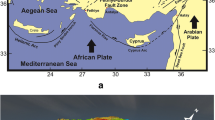Summary
The faulted contact along the boundary of the Archean, metamorphics and Lower Gondwana sedimentaries near Tenughat (23° 44°:85°50°) cuts across the alignment of the dam axis at CH. 114.00 on the left abutment. This fault is known as the “boundary fault” which tends to limit the extension of coal-bearing Gondwana rocks. It has caused considerable displacement of these formations and the rocks are severely crushed, shattered and indurated. The rocks are highly weathered down to 20 m depth and even below this depth the rocks are not competent because of erratic weathering along various shear and joint planes. The 72 m wide Damodar river bed, across which a 50 m high earth dam has been built, is not suitable for the location of its spillway, because of the presence of 15 m thick sand in the river channel. Hence the spillway of this dam was constructed on the higher reaches of the right bank entirely over metamorphic rocks where foundation grade fresh rock was available within 15 m depths. Besides, the location of the spillway here has reduced excavation depth and its height thereby helped in its economical construction.
The boundary fault zone has a high permeability and a grout curtain has been provided along the central line of cut-off trench with a clay blanket towards the upstream side to check seepage of reservoir water. On conducting water percolation tests after grouting, it has been noted that the permeability of the bedrocks has been substantially reduced but certain grouted zones show erratic results. Over and above these remedial measures, a number of relief wells have been provided at the toe of the dam to intercept and release the water pressure caused by seepage through its foundation.
Though this fault is seismically dead, a programme is afoot to establish seismological stations on a triangular grid pattern around the dam to record earth tremors which might originate from this fault plane.
Résumé
Le contact par faille le long de la limite des roches métamorphiques archéennes et des sédiments du Gondwana inférieur, près de Tenughat (23° 44°;85°50°) coupe la direction de l'axe du barrage à CH. 114.00 sur l'appui de la rive gauche. Cette faille est connue comme la “faille limite” qui a pour effet de limiter l'extension des formations houillères du Gondwana. Elle a causé un déplacement considérable de ces formations; aussi les roches sont tres broyées, brisées et indurées. Les roches sont très altérées jusqu'à une profondeur de 20 m; au delà de cette profondeur, les propriétés mécaniques ne sont pas homogenes car il y a des passées irrégulières altérées le long de certains plans de cisaillement et de certains fissures. La vallée du Damodar, large de 72 m, au travers de laquelle un barrage de terre de 50 m de haut a été construit, n'est pas utilisable pour la mise en place de son déversoir parce qu'il y a quinze mètres de sable dans le lit de la rivière. Aussi le déversoir fut-il construit sur la rive droite, entièrement par dessus les roches métamorphiques où la roche saine, de qualité convenant aux fondations, était présente à des profondeurs d'environ 15 m. En outre la mise en place du déversoir à cet endroit avait réduit la profondeur d'excavation et permis une construction plus économique.
La zone de la faille limite a une grande perméabilité et un voile de ciment avait été prévu le long de la ligne centrale de la tranchée, avec une nappe d'argile du côté amont pour éviter l'infiltration de l'eau du réservoir. Lors d'essais de percolation de l'eau après injection de ciment, on remarqua que la perméabilité du bedrock avait sensiblement diminué mais que certaines zones injectées présentatient des résultats aberrants. En plus de ces, mesures confortatives, de nombreux, puisards avaient été prévus au pied du barrage pour couper et relâcher la pression de l'eau due à l'infiltration au travers de sa fondation.
Bien que cette faille soit séismiquement inerte, un programme est préparé pour établir les stations séismologiques sur un canevas triangulaire autour du barrage et enregistrer les vibrations de la terre qui pourraient provenir de ce plan de faille.
Similar content being viewed by others
References
AUDEN J.B. (1948): Notes on earthquakes in relation to Damodar Valley Projects.
CHOWDHURY A.K. (1968–69): Progress report for the period December 1967 to June 1968. Tenughat Dam Project. Hazaribagh district, Bihar. (Unpublished report of Geological Survey of India).
CHOWDHURY A.K. (1975): Tenughat Dam Project, Bihar (Geol. Survey of India, Miscellaneous Publication No. 29, 208–216).
SINGH V.P. (Oct. 1967): The geotechnical note on the Tenughat Dam Project, Hazaribagh district, Bihar (Progress Report for the years 1966–67). (Unpublished report of Geological Survey of India).
SINGH V.P. (1971): Geomechanism of the foundation conditions of Tenughat dam spillway, Hazaribagh district, Bihar. (Journal of Engineering Geology, Symposium on Rock, Mechanics, VI, No. 1, 221–224).
Author information
Authors and Affiliations
Rights and permissions
About this article
Cite this article
Singh, V.P. The boundary fault and its implication for the Tenughat dam, Hazaribagh district, Bihar (India). Bulletin of the International Association of Engineering Geology 20, 69–73 (1979). https://doi.org/10.1007/BF02591249
Published:
Issue Date:
DOI: https://doi.org/10.1007/BF02591249




